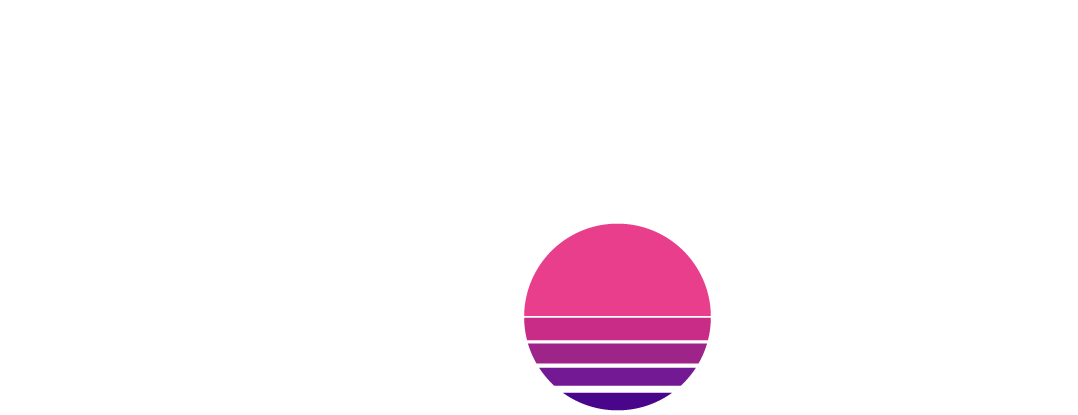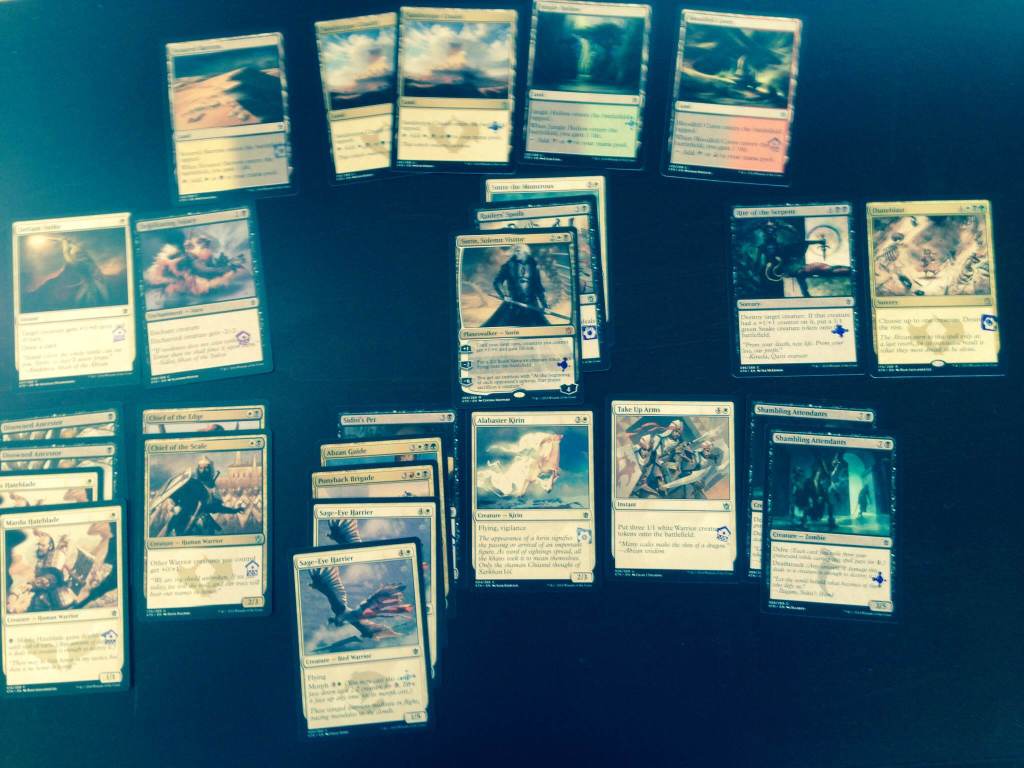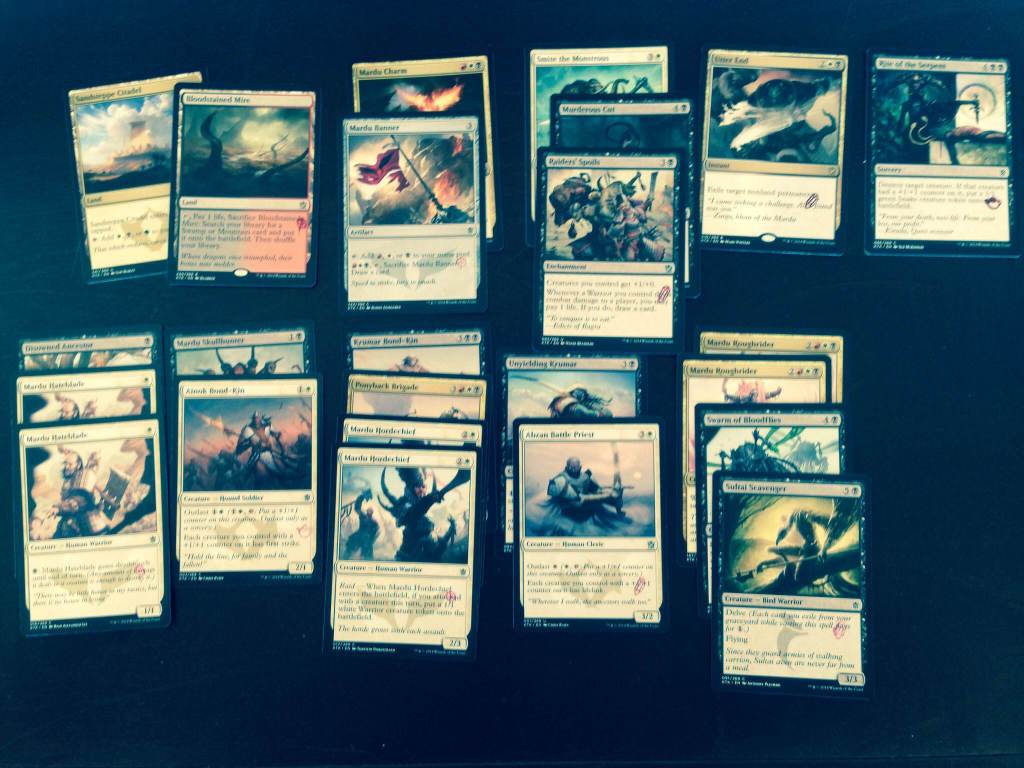Reader, today let us talk about our Limited manabases. Have you been counting mana symbols and using the ratio to pick your lands? Have you been accepting MODO’s suggestions without question? Have you been blaming your mana issues on the gods of variance rather than taking a few moments to truly consider the lands you were adding to your deck?
With a multicolor set just released, there is no better time to face our manabase lazyness. Let’s start with my personal manabase rules.
1. Splashing is a privilege, not a right.
If you want to splash, you need the mana to support the splash. You can’t just trim land from your primary colors willy-nilly! If your lands can’ t properly support the splash, you may just have to sacrifice that off-color removal spell.
2. You must mulligan based on your mana.
Most draft decks have at least two primary colors. If your opening hand is missing a primary color, it is almost never acceptable to keep.
3. Eight is good, more is great.
The magic number for a primary color in your deck is eight sources.
More is better, of course, and spells like [casthaven]Precinct Captain[/casthaven] demand more, but you should never go below eight sources for a primary color.
4. Balanced mana is best.
Between your primary colors, you should lean your mana base towards balance rather than towards matching the exact ratios of colored mana symbols. You need all your colors to operate your deck, and missing a color completely is much more detrimental than having an awkward mix.
5. For splashes, mana should outnumber spells.
Splash mana is just colorless when you don’t draw the spells. Colorless mana is useful! If you don’t draw the mana, though, the spells are just dead draws, and that’s a recipe for disaster.
So how do we put these guidelines into practice? Let’s use my first draft deck from PT Khans as a warmup. The draft went well, and I ended up with this beauty, which I guided to a respectable, if underwhelming, 2-1 record:
There’s a lot of Khansy fun going on here! We’ve got five multi-lands, two primary colors, a splash (green), and a mini-splash (red). There are plenty of mixes of basic lands that make sense here, so how to approach it?
The first question to ask is: “How many colored mana do we get?” The answer is determined by this simple formula:
L + D + (2*T) + F
‘L’ is the number of lands we are playing. ‘D’ is the number of dual lands we have. ‘T’ is the number of triple lands we have. ‘F’ is the number of fixing mana symbols we have. A [casthaven]Rattleclaw Mystic[/casthaven], since it really only helps to produce blue and red (since you have to have green to cast it w/o its morph cost), can count for as much as two, assuming both red and blue were useful to you. This is an 18-land deck, so we have:
18 + 3 + (2*2) = 25 mana symbols.
Now, we break up our 25 mana symbols across our four colors, and the number of basics we need to play quickly becomes apparent!
How to split them up, though? Good question. Here we go:
- Start with your primary colors. You need at least eight of each, so that’s 16.
- If you have room, get your splash colors into a comfortable place. The lands already offer three green and one red mana: Let’s pad that with one more of each to get to four and two. Now we have used 22 colored mana, leaving us three more.
- If you still have room, pad your primary colors and risky splashes. This deck doesn’t have risky splashes: Only [casthaven]Duneblast[/casthaven] is useless without splash mana, and it costs seven mana with four green already. We fill out with one more white mana and two more black mana, because all the one-drops have black activated abilities.
- Add your basics based on your numbers and non-basic lands. To get to ten black mana, we need five Swamps; for nine white, six Plains; for four green, one Forest; for two red, one Mountain. That’s 13 basics, plus our five non-basics, and we are at 18. Voila.
The deck gave me very little mana trouble, although I did flood a bit.
Now, let’s try the technique on this more challenging second draft deck. Someone to my right was scarfing up all the multi-lands, and we ended up with this:
Feel free to come up with a mix of basics to fill this one out: There’s room for 18 total land.
How does our formula work here? Well, L = 18 is easy. Then D = 1 and T = 1, right? Unfortunately not. That triple-land only produces two useful colors for us, so it’s D = 2 and T = 0. I assign F the value of 1 here, as Mardu Banner isn’t fixing for our primary colors: We need them sooner than that! We consider it a red source for the purpose of building our mana base. So we have:
18 + 2 + 0 + 1 = 21.
21 is not as luxurious as the 25 from our last deck, and our red splash is much more demanding to boot!
Step 1 is to feed our primary colors. That means at least eight white and eight black mana, leaving us with only five to spare.
Step 2 is to feed our splash: We have four red cards, but they aren’t the patient kind of splash cards that [casthaven]Duneblast[/casthaven] is. [casthaven]Mardu Roughrider[/casthaven] is good late in the game, but he’s at his best on turn five. [casthaven]Mardu Charm[/casthaven] is very versatile, but four damage is way more meaningful early in the game than late, when the big boys start unmorphing. We want our red, and we want our red mana to outnumber our red cards. We need all five of our remaining colored mana here.
Now we’ve used up all 25 colored mana, so we pick out our basics and go. If it makes you nervous to play five red mana in this heavily white and black deck, remember that we have met our thresholds for minimum primary sources, and that we are going to mulligan any hands without white or black mana regardless. Sure, we’d like more, but this draft didn’t give us that option.
This worked out to six Swamps, seven Plains, three Mountains, and a neat 3-0 draft record. Now, you might build this same deck without the banner: I had some reasonable morph creatures in the sideboard, and banners are pretty bad. However, when you started breaking down your mana you’d start to face some tough decisions. I add the Banner before figuring out my mana base, but I knew my mana was going to be tough and that my deck had unusually few three-drops to go with some great five-drops, so including it just made sense.
You might find that as you step through this method, you run out of colored mana sources. The correct way to deal with this is to go back and correct the spells in your deck by reducing a splash, not to try to stretch your mana base beyond its capabilities. Sure, every now and then a draft goes horribly and you have to run the old 6/6/6 mana base, but if that’s happening to you regularly, you have some other drafting issues to confront.
Drafting with Khans is going to tempt us all into playing some ambitious manabases: It’s important to draw the line somewhere!
Gabe Carleton-Barnes has been playing Magic for over 20 years, mostly as a PTQ grinder and intermittently as a Pro Tour competitor. Currently based in Portland, Oregon, where he is an Open Source web developer by day, Gabe lived in Williamsburg, Brooklyn, for three years. While there, he failed to make a documentary about competitive Magic but succeeded in deepening his obsession with the game. Gabe is now a ringleader and community-builder for the competitive Magic scene in Portland, wielding old-timey slang and tired cliches to motivate kids half his age to drive with him to tournaments.





